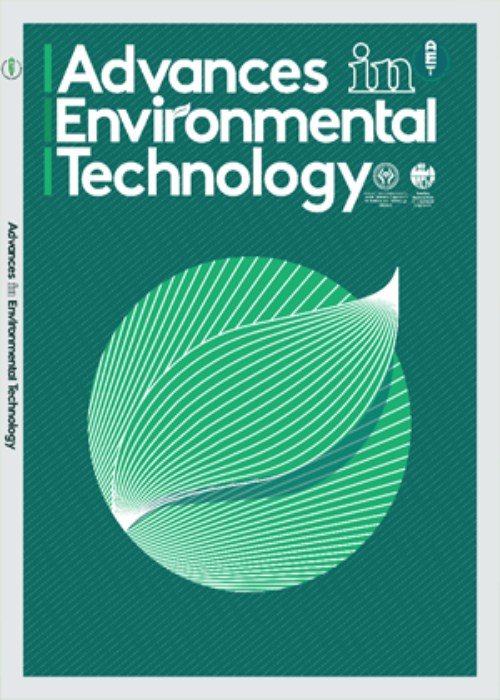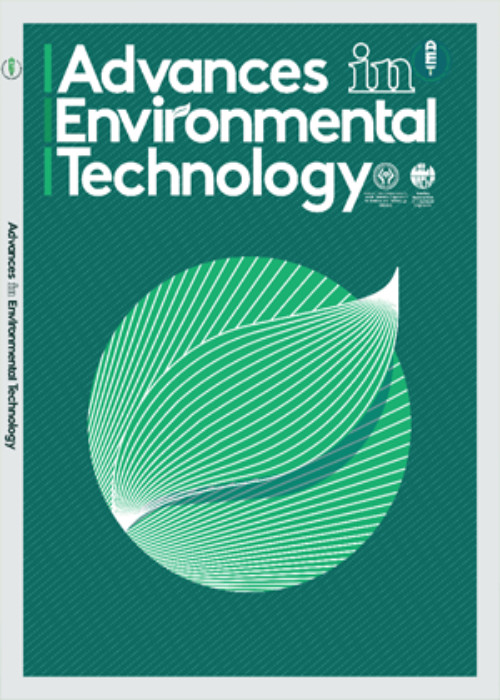فهرست مطالب

Advances in Environmental Technology
Volume:9 Issue: 1, Winter 2023
- تاریخ انتشار: 1401/11/08
- تعداد عناوین: 6
-
-
Pages 1-16Antibiotics are generally applied for the treatment of infections in humans and animals due to their economic value, easy accessibility, and potency. The use of veterinary pharmaceuticals such as antibiotics for the treatment of various infections in aquaculture cannot be overemphasized; the discharge of aquaculture effluent without necessary remediation techniques leads to the toxicity of the ecosystem. In this work, zinc oxide hexagonal-nanorods were synthesized via a precipitation method and calcined at 5000C in a muffle furnace for the catalytic degradation of ciprofloxacin (CIP) formulated aquaculture effluent. The characterization of nano-sized ZnO (n-ZnO) was conducted using scanning electron microscopy-electron dispersive spectroscopy (SEM-EDS), transmission electron microscopy (TEM), x-ray diffraction (XRD), Fourier transmission infrared spectroscopy (FTIR) and Brunauer, Emmett and Teller (BET) surface area determination. The SEM micrograph depicted both hexagonal and rod-like structures. The TEM micrograph subjected to ImageJ software showed an average particle size of 42.69 nm. The weight percent of the elements from the electron dispersive spectroscopy (EDS) followed the trend of Zn>O>C>Cl. The sharp peak of the Zn-O band was observed around 463.12 cm-1. The results from XRD showed that pure n-ZnO was achieved at a temperature of 5000C with a BET surface area of 8.3 m2/g, pore volume of 0.072 cm3/g, and pore size of 184.77 A0. The percentage of chemical oxygen demand (COD) removal of CIP formulated aquaculture effluent followed the trend of 42.8%, 73.9%, and 94.8% for the ultrasound (US), US/n-ZnO, and US/n-ZnO/H2O2systems.The US/n-ZnO/H2O2system showed the highest removal efficiency of CIP from the aquaculture effluent. The kinetics best fit the pseudo-second order, while the mechanism of degradation followed the Langmuir-Hinshelwood model for the US/n-ZnO/H2O2system. Hence, the utilization of US/n-ZnO/H2O2for the degradation of CIP formulated aquaculture effluent has proven to be a sustainable system that is dependable, faster, less tedious, and does not generate additional waste superior performance compared to individual materials. As such, findings from this study confirmed the performance and effectiveness of the Mg-(OH)2-Ca-NPs nanocomposite on the removal of Mn from real river water. This will go a long way in curtailing the impacts of Mn in drinking water and further afield.Keywords: Sonolysis, Antibiotics, Langmuir-Hinshelwood model, Advanced Oxidation Process
-
Pages 17-31A cavity-bubble oxidation reactor was used to study the degradation of patent blue V. The generation of cavity-bubbles by glass balls and flow-rate-induced jet were the degradation mechanisms used in this reactor. Initially, basic operating parameters were optimized by varying the initial concentration (10–40 ppm) and solution pH 2–12. The extent of degradation (22.6%) at 20 ppm was reduced to 11.4% when the initial concentration was increased to 40 ppm. Following that, combined treatment strategies for process intensification of the degradation process were investigated. It was found that lower initial concentrations and acidic conditions favored the degradation of patent blue V. Under the optimal conditions of a concentration of 20 ppm and a pH of 2, the combined effect of the cavity-bubble oxidation reactor and chemical oxidation processes, such as hydrogen peroxide, gave a 95.38% extent of degradation at optimum H2O2 loading (2.5 g/L), which was 4.5 times greater than that obtained using cavity bubble oxidation reactors alone. The highest degree of degradation (98.48%) was achieved with a cavity-bubble oxidation reactor coupled with an optimum loading of the Fenton reagent (0.125 g/L FeSO4 and 2.5 g/L hydrogen peroxide). With the exception of the Fenton process, the kinetic analysis revealed that the degradation of patent blue V followed first-order reaction kinetics in all cases.Keywords: Fenton, Cavitation, Patent blue V, Process intensification, Advanced Oxidation Process
-
Pages 33-46
This study investigated the performance and adsorption properties of multi-magnetic carbon nanotubes in removing paclitaxel (PTX) and gemcitabine (GEM) from industrial sewage. For this purpose, the first magnetic multi-walled carbon nanotubes were prepared by the co-sedimentation method. Their characteristics were determined by scanning electron microscopy analysis of field emission (FESEM), transmission electron microscopy (TEM), energy dispersive x-ray (EDX), X-ray diffraction (XRD), and a vibration sample magnetometer. The results showed that iron oxide nanoparticles were incorporated well without destroying the structure of the nanotubes. Also, the effect of the pH solution and adsorbent dosage on the adsorption of drugs was examined. The pH of 7 and adsorbent dosage of 200 mg/L were found to be the optimal conditions for the process. Comparing the removal results of paclitaxel and gemcitabine contaminants from the sewage showed that the multi-magnetic carbon wall nanotubes were more efficient in removing PTX (58%) than GEM (26%). Studies on the reaction kinetics and adsorption isotherms were performed on the two contaminants. The results obtained from the fitting of the curve showed that the kinetics reaction of the drugs was of the second order and consistent with the Langmuir isotherm. Finally, the reusability and stability of the adsorbent were investigated, and the reductions detected for PTX and GEM were only 8% and 5%, respectively, after five cycles.
Keywords: Multi-walled carbon nanotubes, Iron oxide, Adsorption, Paclitaxel, Gemcitabine -
Pages 47-57This study evaluated the ability of Chlorella vulgaris, a freshwater microalgae species, to remove nutrients from raw municipal wastewater. The wastewater was collected from the initial sedimentation-stage discharge of the treatment plant and used to cultivate the microalgae in both a shaker-incubator and a photobioreactor. The results showed that the microalgae effectively reduced the nitrate, nitrite, phosphate, and ammonium ion concentrations in the wastewater by over 90%. Phosphate removal was particularly efficient in the photobioreactor, with a removal rate of 91%, while the shaker- incubator had a removal rate of 44%. In addition to removing nutrients, the microalgae were also able to significantly reduce the wastewater’s chemical oxygen demand (COD), with a reduction of over 90% from 264 to 23.1 mg/l. The microalgae also had a symbiotic effect on the bacterial colonies present in the wastewater, reducing their numbers by 99% while allowing the microalgae to thrive. The final biomass concentration in the photobioreactor was 2.03 g/l, a higher value compared to similar studies. These results demonstrate the potential of Chlorella vulgaris and other microalgae species for use in wastewater treatment systems.Keywords: Chlorella vulgaris, Microalgae, Photobioreactor, Municipal wastewater, Bacteria
-
Acacia trees-legumes potential for phytoremediation of urban landfill soil in Bonoua (Côte d’Ivoire)Pages 59-71Landfills in urban areas contribute to soil and water pollution with heavy metals. In Côte d’Ivoire, urban landfill soil is used to produce food, which presents health risks. This study evaluates the growth capacity of Acacia spp. trees-legumes (Acacia mangium, Acacia auriculiformis, and Acacia crassicarpa) and their potential for landfill soil remediation and restorations. These trees-legumes were grown under controlled conditions for six months in polluted soils sampled from urban landfills located in southeastern Côte d'Ivoire. The study used a simple, completely randomized design with four treatments (Acacia mangium, Acacia auriculiformis, Acacia crassicarpa, and control) and five replicates. Growth parameters, soil pH, metal contents (bulk soil, leachate), and plants were measured during this experiment. The results indicated that Acacia auriculiformis and Acacia mangium displayed better growth indicators (dry biomass, heights, and number of phyllodes) compared to Acacia crassicarpa. The soil pH under the trees-legumes indicated a significant decrease compared to the control (p < 0.05). In addition, heavy metal contents significantly decreased in the leached solutions of the planted soil compared to the control (p < 0.05). In the exchangeable soil fraction, only the Acacia auriculiformis treatment showed a significant decrease in Zn compared to the control. Regarding the plants, Acacia auriculiformis showed the highest amounts of Pb (111 µg plant-1) and Cd (54 µg plant-1) in total biomasses. Acacia crassicarpa had the highest metal extraction capacity from the polluted soil (Pb: 24 µg plant‑1, Cr: 11 µg plant-1, Cd: 14 µg plant-1, and Zn: 83 µg plant-1) compared to the two other species. The Acacia crassicarpa species appears to be the best one for the phytoremediation of landfill soils.Keywords: Urban landfills, polluted soils, Heavy metals, Acacia spp, phytoremediation
-
Pages 73-83The adverse effects caused by the increase in nitrate concentration in drinking water have prompted researchers to find green and economical methods for nitrate removal. Mineral materials are suggested for this purpose due to their economic and environmental benefits. In this study, Iranian natural zeolite was used for this purpose. An organic surfactant, HDTMA-Br, was used to modify the natural zeolite. Fourier-transform infrared spectroscopy (FTIR) verified that the surfactant was loaded on the zeolite surface. The influence of various parameters on adsorption was studied using the Taguchi method. They were screened by Taguchi’s L8 array, and four significant variables were determined: mass of adsorbent, particle size, contact time, and competing anion concentration. The Taguchi L9 array was used to determine the optimum condition of these significant variables. Analysis of the results showed that the concentration of the competing anion was the most significant variable on the nitrate adsorption by the surfactant modified zeolite (SMZ). In the optimum conditions, SMZ removed about 90% of nitrate from the aqueous solution obtained at a 20 mg/L initial nitrate concentration, 10 min contact time, 15 g adsorbent, and without any competing anion. The study of the adsorption isotherms showed that the nitrate adsorption process by SMZ from the aqueous solution fits well with the Freundlich and linear models.Keywords: Adsorption, Sabzevar zeolite, Taguchi method, Nitrate


